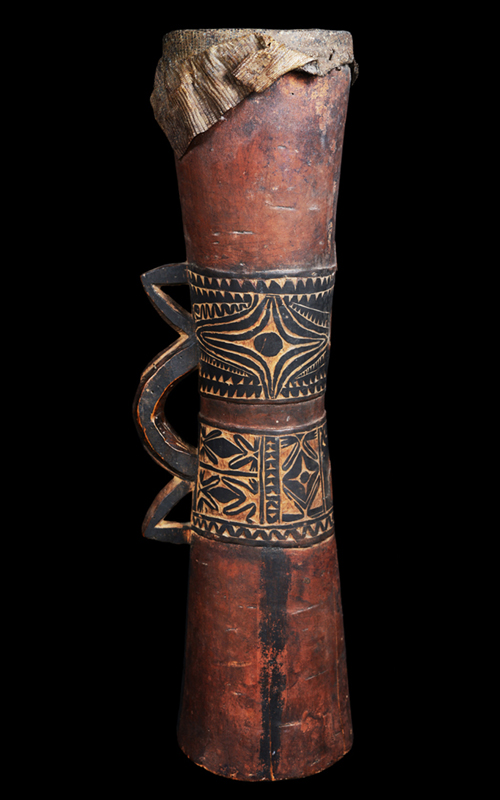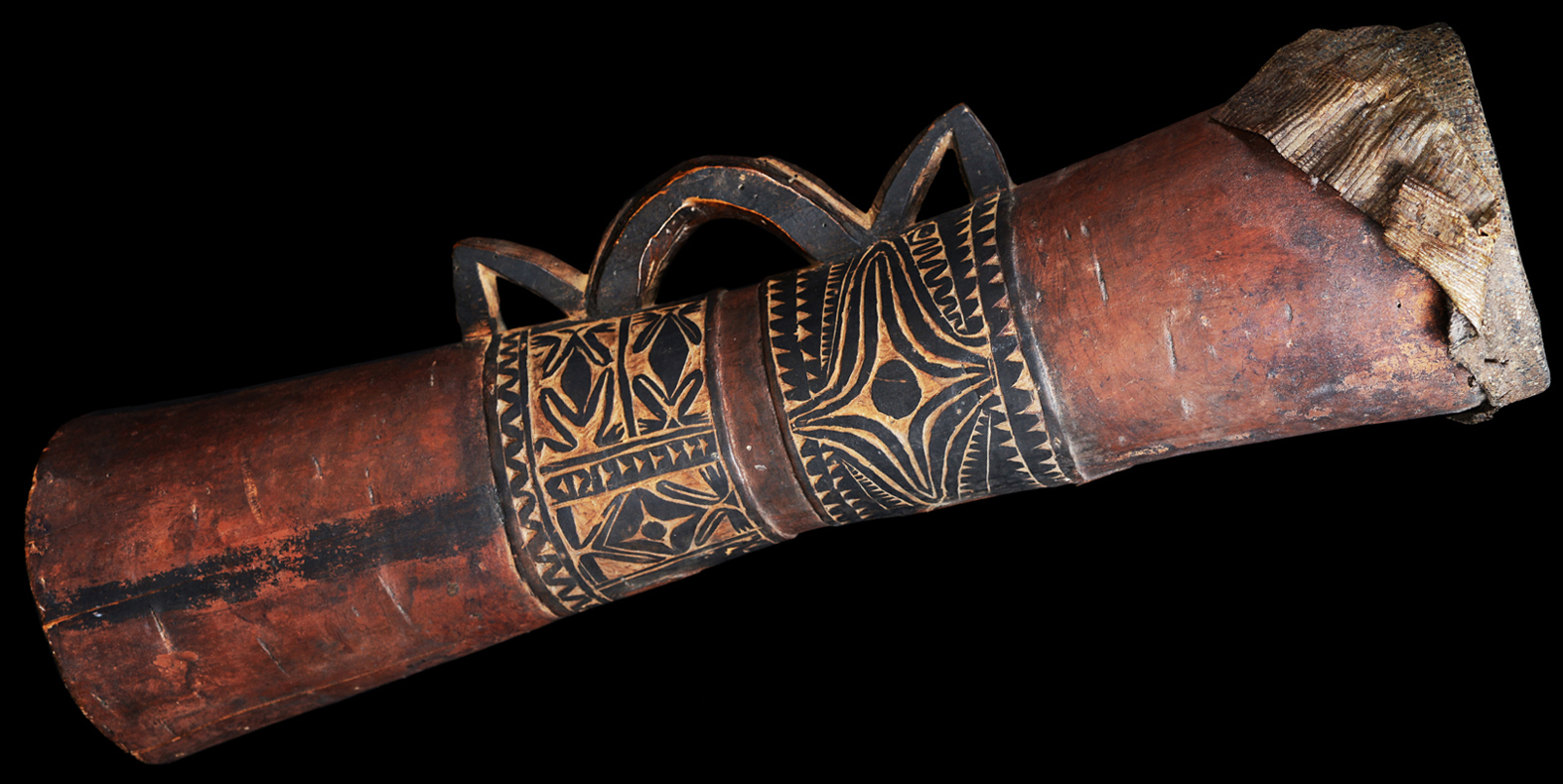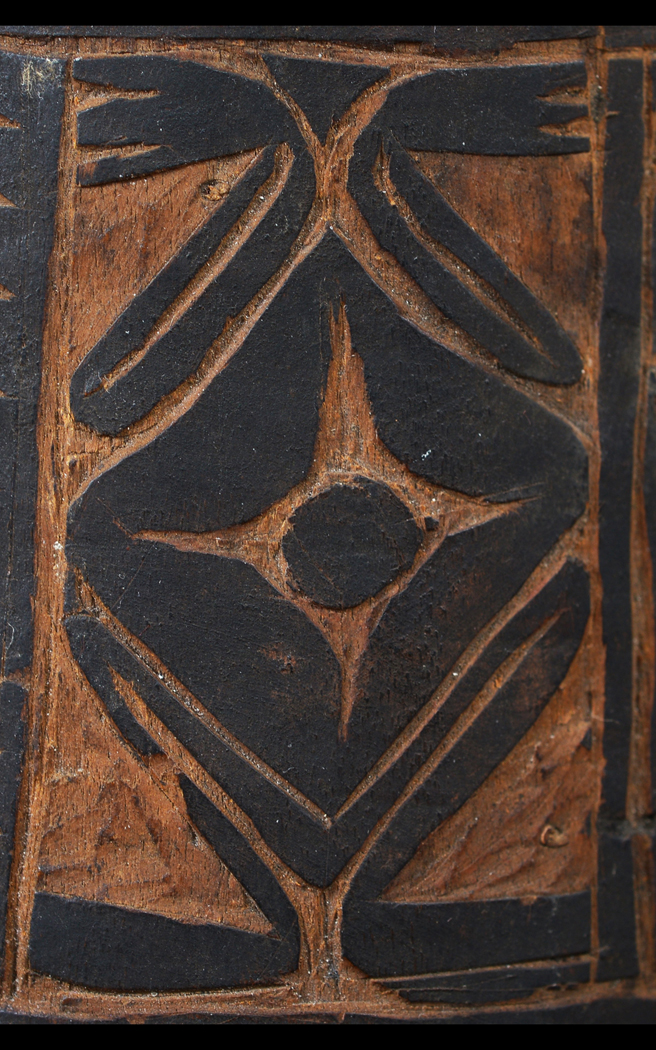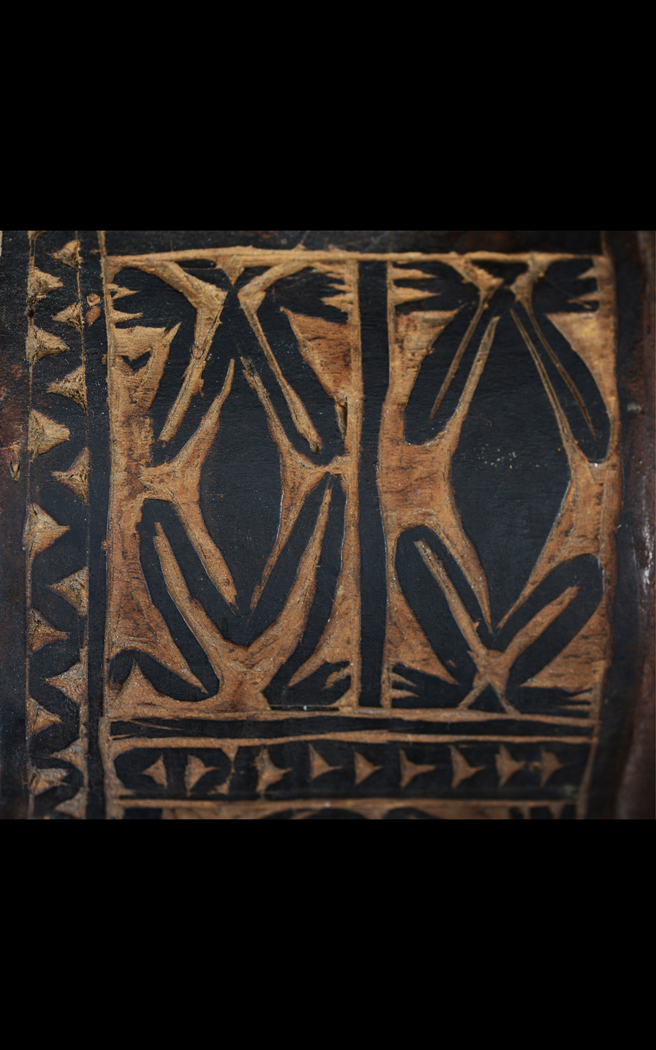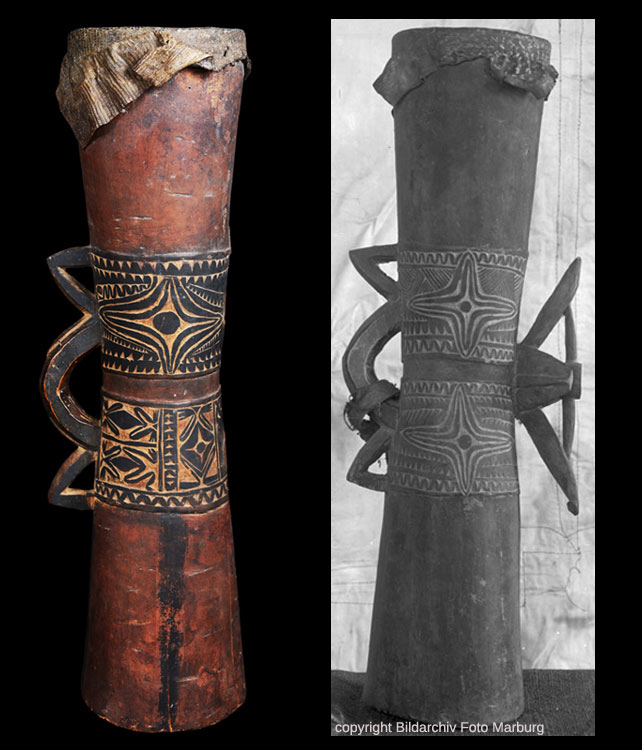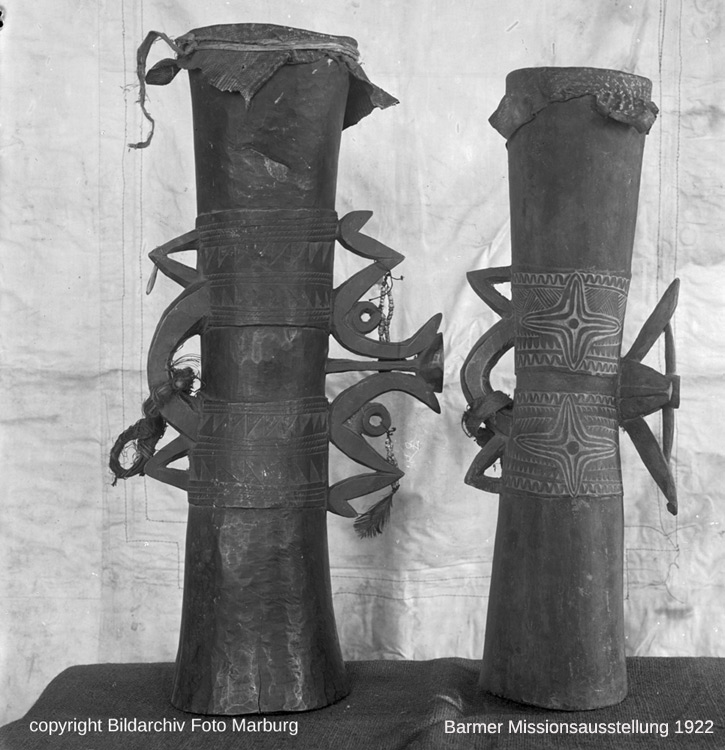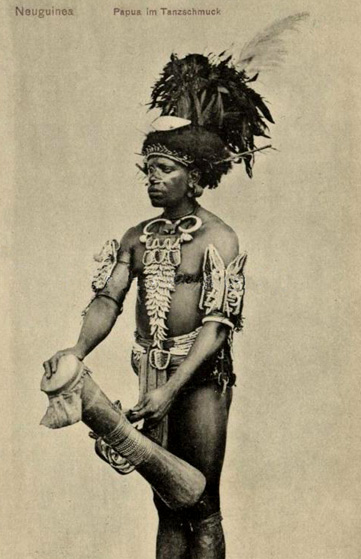DRUMS OF THE WORLD
New Guinea
Astrolabe Bay drum New Guinea
Astrolabe Bay drum / Trommel / Tambour Papua New Guinea / Neuguinea
Unique ancestor figures. The figures have elbows and knees bent in praying mantis position. I would be amazed to learn that there are other such Astrolabe Bay drums with ancestor figures in any collection in the world. Carving at the opposite side of the handle is missing. It comes from an old German ( Wuppertal-Barmen ) collection. Probably collected by a missionary from the Barmer Missionary Society.
"The drums of this region are distinguished from the Huon Gulf variety primarily by the handles. These end in a loop, said to represent a snake,whereas the handles of the Huon Gulf drums are perfectly plain. Also, the Astrolabe drums are tubular in shape and very seldom have the semblance of a waist. On the opposite side of the handle there is again the highly carved open- work projection, sometimes much longer than the handle. It is here meant to represent a stylized lizard or snake. No handle bands are present, but a design is incised on two or more raised surfaces, which encircle the centre of the drum.These are always band- like and never jaw shaped. The tympanum is again of Varanus skin, glued on.The open end is left round, and unornamented." (excerpt from the book: Drum Types of Eastern New Guinea, by Aldo Massola ,1957)
Drums on photo No.6 and 7:
Astrolabebai Trommel
Barmer Missionsausstellung 1922
Aufnahme-Nr.fm626716 Trommeln
copyright: Bildarchiv Foto Marburg
"The Russian traveller, Baron MikluchoMaclay, has described a curious funeral ceremony which is observed by some of the Papuans of Astrolabe Bay. I will give the first part of his description in his own words, which I translate from the German. He says:"
"The death of a man is announced to the neighbouring villages by a definite series of beats on the drum. On the same day or the next morning the whole male population assembles in the vicinity of the village of the deceased. All the men are in full warlike array. To the beat of drum the guests march into the village, where a crowd of men, also armed for war, await the new-comers beside the dead man's hut. After a short parley the men divide into two opposite camps, and there upon a sham fight takes place. However, the combatants go to work very gingerly and make no use of their spears. But dozens of arrows are continually discharged, and not a few are wounded in the sham fight, though not seriously. The nearest relations and friends of the deceased appear especially excited and behave as if they were frantic. When all are hot and tired and all arrows have been shot away, the pretended enemies seat themselves in a circle and in what follows most of them act as simple spectators."
excerpt from the book: Frazer, James George - The belief in immortality and the worship of the dead. 1913
"The skins of the lizards were simply dried and, without any further preparation, rolled up in a bamboo tube. Before use, the skins were softened in water, stretched tightly over the opening of the drum and firmly bound at the rim; the edge hanging out under the binding was pulled from all sides until the drumhead became evenly taut. First, however, the rim of the drum was smeared with the juice of a tree which glued the skin securely to the wood on drying. Another important material was the wax supplied by the stingless Trigona bees, pea-sized pieces of which were rolled and stuck to the drumhead. If these wax pieces were hit, the drum gave a pleasanter sound. During the dance every man had a nut-sized piece of wax stuck to the handle of the drum, to replace pieces which came off. If the skin began to sag during the dance, it was warmed at the fire to make it taut again, and it was occasionally beaten to tune it."
excerpt from: Bodrogi, Tibor (1961), Art in North-East New Guinea.p.79-81. Budapest: Hungarian Academy of Science.
Bibliography:
Bodrogi, Tibor (1950) Yabim Drums in the Bíró Collection / Yabim-típusú dobok a Bíró-gyűjteményben. Néprajzi Múzeum.
Bodrogi, T. 1959, New Guinea Style Provinces: The Style Province “Astrolabe Bay”.In: Opuscula Ethnologica Memoriae Ludovici Biro Sacra (Hungarian Academy of Sciences, Budapest) Vol. 6, pp. 39-99.
Bodrogi, T. 1961, Art in North-East New Guinea. Budapest: Hungarian Academy of Sciences.
Biro, Lajos 1901, Beschreibender Catalog der Ethnographischen Sammlung Ludwig Biro’s aus Deutsch-Neu-Guinea (Astrolabe-Bai). [Beschreibungen von Willibald Semayer.] Ethnographische Sammlungen des Ungarischen Nationalsmuseums III. Budapest. Német-új-Guineai (Astrolabe-Öböl) néprajzi gyűjtésének leíró jegyzéke. Magyar Nemzeti Múzeum Néprajzi gyűjteményei.
Biro, Lajos : Hét év Új-Guineában : levelek két világrészből.
Finsch, Otto (1888) Reisen in Kaiser Wilhelms-Land und Neu-Guinea an Bord des Dampfers Samoa.
Finsch, Otto (1888)Ethnologische Erfahrungen und Belegstücke aus der Südsee: beschreibender Katalog einer Sammlung im K.K. Naturhistorischen Hofmuseum in Wien.
Massola Aldo : Drum Types of Eastern New Guinea 1957
Hamson, Michael (Editor): Between the Known and Unknown : New Guinea Art from Astrolabe Bay to Morobe. Contributions by : Crispin Howarth, Christin Kocher Schmid, Dieter Klein, Fritz Klusmeier, Klaus Maaz, Virginia-Lee Webb, Robert L. Welsch, Arnold Wentholt, Gabor Vargyas
Vargyas Gabor : Art of Astrolabe Bay. In: Art and Performance in Oceania. Edited by: Barry Craig, Bernie Kernot, Christopher Anderson.
Frazer, James George, The belief in immortality and the worship of the dead. 1913
Biró, Lajos (ed. by Jankó, János) (1899): Beschreibender Catalog der ethnographischen Sammlung Ludwig Biró-s aus Deutsch-Neu-Guinea (Berlinhafen). Budapest.
Biró, Lajos (ed. by Seemayer, Villibald) (1901): Beschreibender Catalog der ethnographischen Sammlung Ludwig Biró-s ausDeutsch-Neu-Guinea (Astrolabe-Bai). Budapest.
Biró, Lajos (1923): Hét év Új-Guineában. Levelek két világrészb l. [Seven years in New Guinea. Letters from two continents. In Hungarian.] Budapest: Világirodalom.
Biró, Lajos (1932): Újguineai utazásom emlékei [Memories of my Travels in New Guinea. In Hungarian] Budapest: Királyi Magyar Természettudományi Társulat.
Bodrogi, Tibor (1953): Some Notes on the Ethnography of New Guinea. I. Initiation Rites and Ghost-Cult in the Astrolabe Bay Region. Acta Ethnographica, III: 91–144.
Bodrogi, Tibor (1959): New Guinean Style Provinces. The Style Province “Astrolabe Bay.” In T. Bodrogi and L. Boglár (eds.) (): Opuscula Ethnologica Memoriae Ludovici Bíró Sacra. Bp.Akadémiai K., 39–99.
Bodrogi, Tibor (1978-80): A Mask from the Astrolabe Bay Area. The Minneapolis Institute of Arts Bulletin, LXIV: 80–87.
Bodrogi, Tibor (1979): Style Provinces and Trading Areas in North and Northeast New Guinea. In S. Mead (ed.): Exploring the Visual Art of Oceania. The University Press of Hawaii, Honolulu, 265–277.
Bodrogi, Tibor (1982): M vészet Észak-Új-Guineában, az Astrolabeöböl térségében. [Art in Northeast New Guinea, in the Astrolabe Bay Area] M vészet, Vol. XXIII. Nr. 10. 39–43.
Bodrogi, Tibor (1990): Between the Invisible and the Tangible. The Role of Art in Communication Between the Two Realms. An Example from Papua New Guinea.
Czapli ka, Maria Antonina (1914): Life and Work of N. N. Miklukho-Maklay. Man, No.98. 198–203.
Gyarmati, János (ed.by) (2008): Taking them back to my homeland…Hungarian Collectors – Non-European Collections of the Museum of Ethnography in a European Context. Budapest: Museum of Ethnography.
Finsch, Otto (1865): Neu-Guinea und Seine Bewohner. Bremen.
Finsch, Otto (1886a) Katalog der ethnologischen Sammlung der Neu-Guinea-Compagnie, ausgestellt im königl. Museum fürVölkerkunde (Berlin 1886)
Finsch, Otto (1888a): Samoa-Fahrten. Reisen in Kaiser Wilhelms-Land und Englisch-Neu-Guinea in den Jahren 1884 und 1885 an Bord des Deutschen Dampfers “Samoa.” Leipzig, Ferdinand Hirt & Sohn.
Finsch, Otto (1914): Südseearbeiten. Gewerbe- und Kunstfleiss, Tauschmittel und “Geld” der Eingeborenen auf Grundlage der Rohstoffe und der geographischen Verbreitung. Hamburg: L.Friedrichsen & Co.
Haddon, Alfred C. (1894): The Decorative Art of British New Guinea. Cunningham Memoirs No.10. Dublin.
Hagen, Bernhard von (1899): Unter den Papuas in Deutsch-Neu-Guinea. Wiesbaden.
Kriele, Eduard (1927) Das Kreuz unter den Palmen. Die Rheinische Mission in Neu-Guinea. Barmen. Kunze, Georg (1897): Allerlei Bilder aus dem Leben der Papua.
Rheinische Missionsschriften, H. 3. Barmen. Lauterbach, Carl (1891): Eine Expedition zur Erforschung des Hinterlandes der Astrolabe-Bai. Nachrichten über Kaiser-Wihelms- Land. Vol. VII: 31–62. Berlin.
Miklucho-Maclay, N.N. (1875) Ethnologische Bemerkungen ueber die Papuas der Maclay-Küste in Neu-Guinea. NTN, Deel. XXXV: 66–94.
Miklucho-Maclay, N.N. (1876): Ethnologische Bemerkungen ueber die Papuas der Maclay-Küste in Neu-Guinea. NTN, Deel. XXXVI: 294–334.
Miklucho-Maclay, N. N. (1878): Vestiges de l’art chez les Papouas de la côte Maclay en Nouvelle-Guinée. Bulletin de la Société d’Anthropologie de Paris. Vol. III/1: 524–531.
Mikloucho-Maclay, N. N. (1975): New Guinea Diaries, 1871–1883. (Translated from the Russian with biographical and historical notes by C. L. Sentinella.) Kristen Press, Madang, Papua New Guinea.
Miklouho-Maclay, N. (1982): Travels to New Guinea. Diaries. Letters. Documents.
Neuhauss, Richard (1911): Deutsch-Neu-Guinea. Vols. I–III. Berlin.
New Guinea Art. Masterpieces from the Jolika Collection of Marcia and John Friede (2005). Essays by Gregory Hodgins, Philippe Peltier, Dirk Smidt, and Robert L. Welsch. Vols.1-2. Fine Arts Museums of San Francisco in Association with 5 Continents Editions.
Preuss, Konrad Theodor (1897-98): Künstlerische Darstellungen aus Kaiser-Wilhelms-Land in ihrer Bedeutung für die Ethnographie. Zeitschrift für Ethnologie, Vol. XXIX:77–141
Schmeltz, J. D. E. (1895–1896): Beiträge zur Ethnographie von Neu-Guinea. V. Ueber eine Sammlung aus Konstantinhafen, Astrolabebai.
Steffen, Paul [B.] (1995): Missionsbeginn in Neuguinea. Die Anfänge der Rheinischen, Neuendettelsauer und Steyler Missionarbeit in Neuguinea. (Studia Instituti Missiologici SVD 61.) Steyler Verlag,
Vargyas, Gábor (1986): Data on the Pictorial History of Northeast Papua New Guinea. (Occasional Papers in Anthropology 1.) Budapest, Ethnographical Institute of the Hungarian Academy of Sciences, 1986, 90 pp. and 69 b/w photos.
Vargyas, Gábor (1987): Field Notes from the Astrolabe Bay (Madang Province, Papua New Guinea). (Occasional Papers in Anthropology 2.) Budapest, Ethnographical Institute of theHungarian Academy of Sciences, 1987, 60 pp. and 195 b/w photos.
Vargyas, Gábor (1991): “Bíró, Lajos.” In: International Dictionary of Anthropologists. Compiled by Library-Anthropology Resource Group. General Editor: Christopher Winters. Garland Publishing,New York and London, 61–62.
Vargyas, Gábor (1998): Art of the Astrolabe Bay. History of Research, Results and Future Research Tasks. In Barry Craig – B. Kernot – and Christian Anderson (eds.): Art and Performance in Oceania.Bathurst, Crawford House Publishing, 246–253.
Vargyas, Gábor (2008): The Oceanian Collection. In: J. Gyarmati (ed. by): Taking them back to my homeland... Hungarian Collectors – Non-European Collections of the Museum of Ethnography in a European Context. Budapest, Museum of Ethnography, 207–248.
Vargyas, Gábor (2016): Through Each Other’s Eyes. How the Hungarian Naturalist Lajos Biró saw German Missionaries in New Guinea, and Vice Versa. In M. Hamson (ed.): Between the Known and the Unknown. New Guinea Art from Astrolabe Bay to Morobe. Printed by Cassochrome, Waregem, Belgium, 32–37.
Weiss, Gabriele und Ildikó Cazan-Simányi (2012): Aus dem Pazifik. Ein Sammler aus Leidenschaft. F.H. Otto Finsch (1839-1917). Eine Ausstellung des Museums für Völkerkunde, Wien –Kunsthistorisches Museum.
Welsch, Robert L. (ed.): (1998): An American Anthropologist in Melanesia: A. B. Lewis and the Josph N. Field South Pacific Expedition, 1909–1913. Honolulu: University of Hawai’i Press. (2 vols.)
Welsch, Robert L. (2000): One time, one place, three collections: colonial processes and the shaping of some museum collections from German New Guinea. In Hunting the Gatherers:Ethnographic Collectors, Agents and Agency in Melanesia, 1870s–1930s. Eds. by Michael O’Hanlon and R. L. Welsch. Oxford: Berghahn Books, 55–79.
Welsch, Robert L. (2005): One symphony from many voices: collectors, collecting activities, and the culture of collecting Since 1870. In New Guinea Art. Masterpieces from the Jolika Collection of Marcia and John Friede. Pp.8–29.
Welsch, Robert L. (2016): Huon Gulf Collections and Collectors: on Understanding the Art of the Huon Peninsula and the Vitiaz Strait. In Hamson, Michael (2016) (ed.): Between the Known and the Unknown. New Guinea Art from Astrolabe Bay to Morobe.
Werner, E. (1911): Kaiser-Wilhelms-Land. Beobachtungen und Erlebnisse in den Urwäldern Neuguinea. Freiburg.
Wichmann, Artur (1909–1912): Entdeckungsgeschichte von Neu-Guinea. 1909: vol.1: Entdeckungsgeschichte von Neu-Guinea bis 1828, 45 maps, 387 pp.; 1910: vol. 2. (1st part): Entdeckungsgeschichte von Neu-Guinea 1828–1885, 37 maps, 369 pp.; 1912: Entdeckungsgeschichte von Neu-Guinea 1885–1902, 36 maps, 1026 pp. Leiden, Brill.
Zöller, Hugo (1891): Deutsch-Neu-Guinea und meine Ersteigung des Finisterre-Gebirges. Stuttgart–Berlin–Leipzig.
Unique ancestor figures. The figures have elbows and knees bent in praying mantis position. I would be amazed to learn that there are other such Astrolabe Bay drums with ancestor figures in any collection in the world. Carving at the opposite side of the handle is missing. It comes from an old German ( Wuppertal-Barmen ) collection. Probably collected by a missionary from the Barmer Missionary Society.
"The drums of this region are distinguished from the Huon Gulf variety primarily by the handles. These end in a loop, said to represent a snake,whereas the handles of the Huon Gulf drums are perfectly plain. Also, the Astrolabe drums are tubular in shape and very seldom have the semblance of a waist. On the opposite side of the handle there is again the highly carved open- work projection, sometimes much longer than the handle. It is here meant to represent a stylized lizard or snake. No handle bands are present, but a design is incised on two or more raised surfaces, which encircle the centre of the drum.These are always band- like and never jaw shaped. The tympanum is again of Varanus skin, glued on.The open end is left round, and unornamented." (excerpt from the book: Drum Types of Eastern New Guinea, by Aldo Massola ,1957)
Drums on photo No.6 and 7:
Astrolabebai Trommel
Barmer Missionsausstellung 1922
Aufnahme-Nr.fm626716 Trommeln
copyright: Bildarchiv Foto Marburg
"The Russian traveller, Baron MikluchoMaclay, has described a curious funeral ceremony which is observed by some of the Papuans of Astrolabe Bay. I will give the first part of his description in his own words, which I translate from the German. He says:"
"The death of a man is announced to the neighbouring villages by a definite series of beats on the drum. On the same day or the next morning the whole male population assembles in the vicinity of the village of the deceased. All the men are in full warlike array. To the beat of drum the guests march into the village, where a crowd of men, also armed for war, await the new-comers beside the dead man's hut. After a short parley the men divide into two opposite camps, and there upon a sham fight takes place. However, the combatants go to work very gingerly and make no use of their spears. But dozens of arrows are continually discharged, and not a few are wounded in the sham fight, though not seriously. The nearest relations and friends of the deceased appear especially excited and behave as if they were frantic. When all are hot and tired and all arrows have been shot away, the pretended enemies seat themselves in a circle and in what follows most of them act as simple spectators."
excerpt from the book: Frazer, James George - The belief in immortality and the worship of the dead. 1913
"The skins of the lizards were simply dried and, without any further preparation, rolled up in a bamboo tube. Before use, the skins were softened in water, stretched tightly over the opening of the drum and firmly bound at the rim; the edge hanging out under the binding was pulled from all sides until the drumhead became evenly taut. First, however, the rim of the drum was smeared with the juice of a tree which glued the skin securely to the wood on drying. Another important material was the wax supplied by the stingless Trigona bees, pea-sized pieces of which were rolled and stuck to the drumhead. If these wax pieces were hit, the drum gave a pleasanter sound. During the dance every man had a nut-sized piece of wax stuck to the handle of the drum, to replace pieces which came off. If the skin began to sag during the dance, it was warmed at the fire to make it taut again, and it was occasionally beaten to tune it."
excerpt from: Bodrogi, Tibor (1961), Art in North-East New Guinea.p.79-81. Budapest: Hungarian Academy of Science.
Bibliography:
Bodrogi, Tibor (1950) Yabim Drums in the Bíró Collection / Yabim-típusú dobok a Bíró-gyűjteményben. Néprajzi Múzeum.
Bodrogi, T. 1959, New Guinea Style Provinces: The Style Province “Astrolabe Bay”.In: Opuscula Ethnologica Memoriae Ludovici Biro Sacra (Hungarian Academy of Sciences, Budapest) Vol. 6, pp. 39-99.
Bodrogi, T. 1961, Art in North-East New Guinea. Budapest: Hungarian Academy of Sciences.
Biro, Lajos 1901, Beschreibender Catalog der Ethnographischen Sammlung Ludwig Biro’s aus Deutsch-Neu-Guinea (Astrolabe-Bai). [Beschreibungen von Willibald Semayer.] Ethnographische Sammlungen des Ungarischen Nationalsmuseums III. Budapest. Német-új-Guineai (Astrolabe-Öböl) néprajzi gyűjtésének leíró jegyzéke. Magyar Nemzeti Múzeum Néprajzi gyűjteményei.
Biro, Lajos : Hét év Új-Guineában : levelek két világrészből.
Finsch, Otto (1888) Reisen in Kaiser Wilhelms-Land und Neu-Guinea an Bord des Dampfers Samoa.
Finsch, Otto (1888)Ethnologische Erfahrungen und Belegstücke aus der Südsee: beschreibender Katalog einer Sammlung im K.K. Naturhistorischen Hofmuseum in Wien.
Massola Aldo : Drum Types of Eastern New Guinea 1957
Hamson, Michael (Editor): Between the Known and Unknown : New Guinea Art from Astrolabe Bay to Morobe. Contributions by : Crispin Howarth, Christin Kocher Schmid, Dieter Klein, Fritz Klusmeier, Klaus Maaz, Virginia-Lee Webb, Robert L. Welsch, Arnold Wentholt, Gabor Vargyas
Vargyas Gabor : Art of Astrolabe Bay. In: Art and Performance in Oceania. Edited by: Barry Craig, Bernie Kernot, Christopher Anderson.
Frazer, James George, The belief in immortality and the worship of the dead. 1913
Biró, Lajos (ed. by Jankó, János) (1899): Beschreibender Catalog der ethnographischen Sammlung Ludwig Biró-s aus Deutsch-Neu-Guinea (Berlinhafen). Budapest.
Biró, Lajos (ed. by Seemayer, Villibald) (1901): Beschreibender Catalog der ethnographischen Sammlung Ludwig Biró-s ausDeutsch-Neu-Guinea (Astrolabe-Bai). Budapest.
Biró, Lajos (1923): Hét év Új-Guineában. Levelek két világrészb l. [Seven years in New Guinea. Letters from two continents. In Hungarian.] Budapest: Világirodalom.
Biró, Lajos (1932): Újguineai utazásom emlékei [Memories of my Travels in New Guinea. In Hungarian] Budapest: Királyi Magyar Természettudományi Társulat.
Bodrogi, Tibor (1953): Some Notes on the Ethnography of New Guinea. I. Initiation Rites and Ghost-Cult in the Astrolabe Bay Region. Acta Ethnographica, III: 91–144.
Bodrogi, Tibor (1959): New Guinean Style Provinces. The Style Province “Astrolabe Bay.” In T. Bodrogi and L. Boglár (eds.) (): Opuscula Ethnologica Memoriae Ludovici Bíró Sacra. Bp.Akadémiai K., 39–99.
Bodrogi, Tibor (1978-80): A Mask from the Astrolabe Bay Area. The Minneapolis Institute of Arts Bulletin, LXIV: 80–87.
Bodrogi, Tibor (1979): Style Provinces and Trading Areas in North and Northeast New Guinea. In S. Mead (ed.): Exploring the Visual Art of Oceania. The University Press of Hawaii, Honolulu, 265–277.
Bodrogi, Tibor (1982): M vészet Észak-Új-Guineában, az Astrolabeöböl térségében. [Art in Northeast New Guinea, in the Astrolabe Bay Area] M vészet, Vol. XXIII. Nr. 10. 39–43.
Bodrogi, Tibor (1990): Between the Invisible and the Tangible. The Role of Art in Communication Between the Two Realms. An Example from Papua New Guinea.
Czapli ka, Maria Antonina (1914): Life and Work of N. N. Miklukho-Maklay. Man, No.98. 198–203.
Gyarmati, János (ed.by) (2008): Taking them back to my homeland…Hungarian Collectors – Non-European Collections of the Museum of Ethnography in a European Context. Budapest: Museum of Ethnography.
Finsch, Otto (1865): Neu-Guinea und Seine Bewohner. Bremen.
Finsch, Otto (1886a) Katalog der ethnologischen Sammlung der Neu-Guinea-Compagnie, ausgestellt im königl. Museum fürVölkerkunde (Berlin 1886)
Finsch, Otto (1888a): Samoa-Fahrten. Reisen in Kaiser Wilhelms-Land und Englisch-Neu-Guinea in den Jahren 1884 und 1885 an Bord des Deutschen Dampfers “Samoa.” Leipzig, Ferdinand Hirt & Sohn.
Finsch, Otto (1914): Südseearbeiten. Gewerbe- und Kunstfleiss, Tauschmittel und “Geld” der Eingeborenen auf Grundlage der Rohstoffe und der geographischen Verbreitung. Hamburg: L.Friedrichsen & Co.
Haddon, Alfred C. (1894): The Decorative Art of British New Guinea. Cunningham Memoirs No.10. Dublin.
Hagen, Bernhard von (1899): Unter den Papuas in Deutsch-Neu-Guinea. Wiesbaden.
Kriele, Eduard (1927) Das Kreuz unter den Palmen. Die Rheinische Mission in Neu-Guinea. Barmen. Kunze, Georg (1897): Allerlei Bilder aus dem Leben der Papua.
Rheinische Missionsschriften, H. 3. Barmen. Lauterbach, Carl (1891): Eine Expedition zur Erforschung des Hinterlandes der Astrolabe-Bai. Nachrichten über Kaiser-Wihelms- Land. Vol. VII: 31–62. Berlin.
Miklucho-Maclay, N.N. (1875) Ethnologische Bemerkungen ueber die Papuas der Maclay-Küste in Neu-Guinea. NTN, Deel. XXXV: 66–94.
Miklucho-Maclay, N.N. (1876): Ethnologische Bemerkungen ueber die Papuas der Maclay-Küste in Neu-Guinea. NTN, Deel. XXXVI: 294–334.
Miklucho-Maclay, N. N. (1878): Vestiges de l’art chez les Papouas de la côte Maclay en Nouvelle-Guinée. Bulletin de la Société d’Anthropologie de Paris. Vol. III/1: 524–531.
Mikloucho-Maclay, N. N. (1975): New Guinea Diaries, 1871–1883. (Translated from the Russian with biographical and historical notes by C. L. Sentinella.) Kristen Press, Madang, Papua New Guinea.
Miklouho-Maclay, N. (1982): Travels to New Guinea. Diaries. Letters. Documents.
Neuhauss, Richard (1911): Deutsch-Neu-Guinea. Vols. I–III. Berlin.
New Guinea Art. Masterpieces from the Jolika Collection of Marcia and John Friede (2005). Essays by Gregory Hodgins, Philippe Peltier, Dirk Smidt, and Robert L. Welsch. Vols.1-2. Fine Arts Museums of San Francisco in Association with 5 Continents Editions.
Preuss, Konrad Theodor (1897-98): Künstlerische Darstellungen aus Kaiser-Wilhelms-Land in ihrer Bedeutung für die Ethnographie. Zeitschrift für Ethnologie, Vol. XXIX:77–141
Schmeltz, J. D. E. (1895–1896): Beiträge zur Ethnographie von Neu-Guinea. V. Ueber eine Sammlung aus Konstantinhafen, Astrolabebai.
Steffen, Paul [B.] (1995): Missionsbeginn in Neuguinea. Die Anfänge der Rheinischen, Neuendettelsauer und Steyler Missionarbeit in Neuguinea. (Studia Instituti Missiologici SVD 61.) Steyler Verlag,
Vargyas, Gábor (1986): Data on the Pictorial History of Northeast Papua New Guinea. (Occasional Papers in Anthropology 1.) Budapest, Ethnographical Institute of the Hungarian Academy of Sciences, 1986, 90 pp. and 69 b/w photos.
Vargyas, Gábor (1987): Field Notes from the Astrolabe Bay (Madang Province, Papua New Guinea). (Occasional Papers in Anthropology 2.) Budapest, Ethnographical Institute of theHungarian Academy of Sciences, 1987, 60 pp. and 195 b/w photos.
Vargyas, Gábor (1991): “Bíró, Lajos.” In: International Dictionary of Anthropologists. Compiled by Library-Anthropology Resource Group. General Editor: Christopher Winters. Garland Publishing,New York and London, 61–62.
Vargyas, Gábor (1998): Art of the Astrolabe Bay. History of Research, Results and Future Research Tasks. In Barry Craig – B. Kernot – and Christian Anderson (eds.): Art and Performance in Oceania.Bathurst, Crawford House Publishing, 246–253.
Vargyas, Gábor (2008): The Oceanian Collection. In: J. Gyarmati (ed. by): Taking them back to my homeland... Hungarian Collectors – Non-European Collections of the Museum of Ethnography in a European Context. Budapest, Museum of Ethnography, 207–248.
Vargyas, Gábor (2016): Through Each Other’s Eyes. How the Hungarian Naturalist Lajos Biró saw German Missionaries in New Guinea, and Vice Versa. In M. Hamson (ed.): Between the Known and the Unknown. New Guinea Art from Astrolabe Bay to Morobe. Printed by Cassochrome, Waregem, Belgium, 32–37.
Weiss, Gabriele und Ildikó Cazan-Simányi (2012): Aus dem Pazifik. Ein Sammler aus Leidenschaft. F.H. Otto Finsch (1839-1917). Eine Ausstellung des Museums für Völkerkunde, Wien –Kunsthistorisches Museum.
Welsch, Robert L. (ed.): (1998): An American Anthropologist in Melanesia: A. B. Lewis and the Josph N. Field South Pacific Expedition, 1909–1913. Honolulu: University of Hawai’i Press. (2 vols.)
Welsch, Robert L. (2000): One time, one place, three collections: colonial processes and the shaping of some museum collections from German New Guinea. In Hunting the Gatherers:Ethnographic Collectors, Agents and Agency in Melanesia, 1870s–1930s. Eds. by Michael O’Hanlon and R. L. Welsch. Oxford: Berghahn Books, 55–79.
Welsch, Robert L. (2005): One symphony from many voices: collectors, collecting activities, and the culture of collecting Since 1870. In New Guinea Art. Masterpieces from the Jolika Collection of Marcia and John Friede. Pp.8–29.
Welsch, Robert L. (2016): Huon Gulf Collections and Collectors: on Understanding the Art of the Huon Peninsula and the Vitiaz Strait. In Hamson, Michael (2016) (ed.): Between the Known and the Unknown. New Guinea Art from Astrolabe Bay to Morobe.
Werner, E. (1911): Kaiser-Wilhelms-Land. Beobachtungen und Erlebnisse in den Urwäldern Neuguinea. Freiburg.
Wichmann, Artur (1909–1912): Entdeckungsgeschichte von Neu-Guinea. 1909: vol.1: Entdeckungsgeschichte von Neu-Guinea bis 1828, 45 maps, 387 pp.; 1910: vol. 2. (1st part): Entdeckungsgeschichte von Neu-Guinea 1828–1885, 37 maps, 369 pp.; 1912: Entdeckungsgeschichte von Neu-Guinea 1885–1902, 36 maps, 1026 pp. Leiden, Brill.
Zöller, Hugo (1891): Deutsch-Neu-Guinea und meine Ersteigung des Finisterre-Gebirges. Stuttgart–Berlin–Leipzig.
